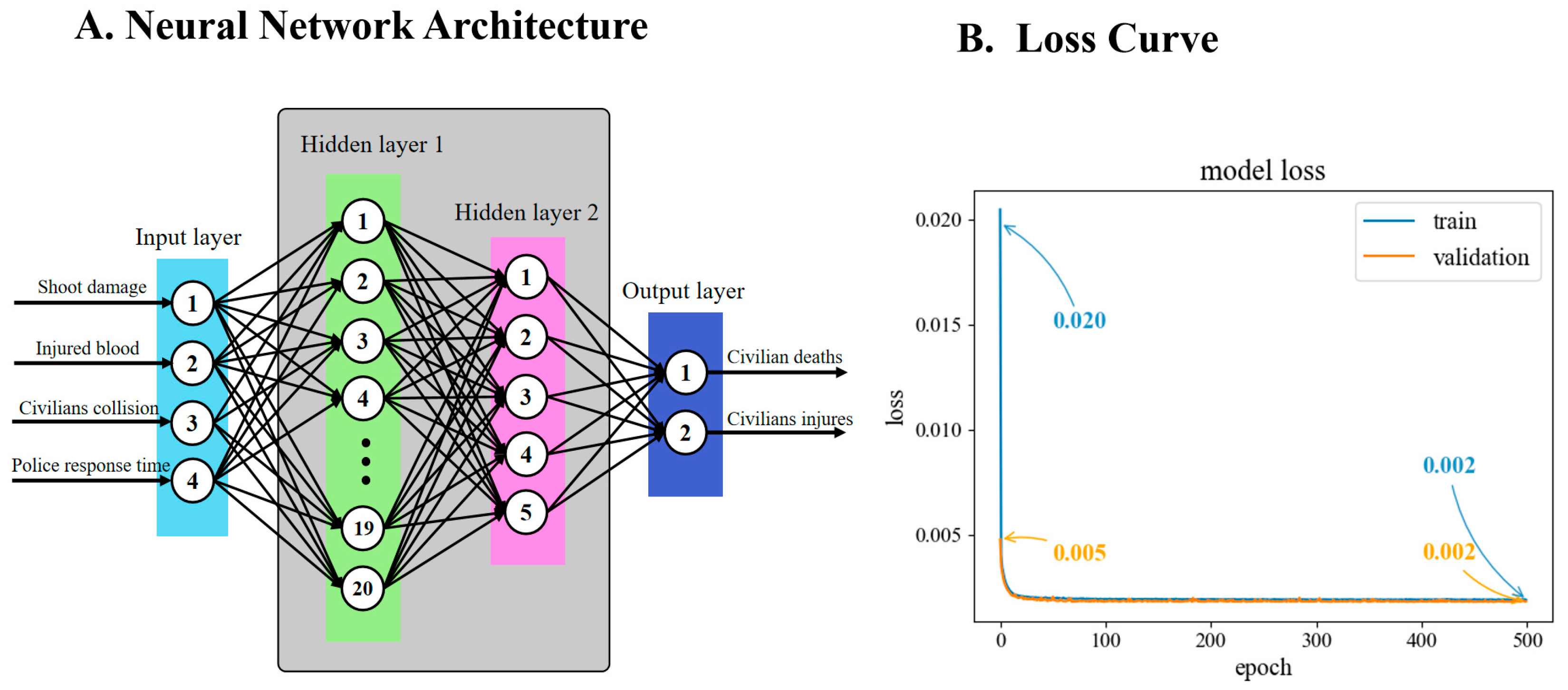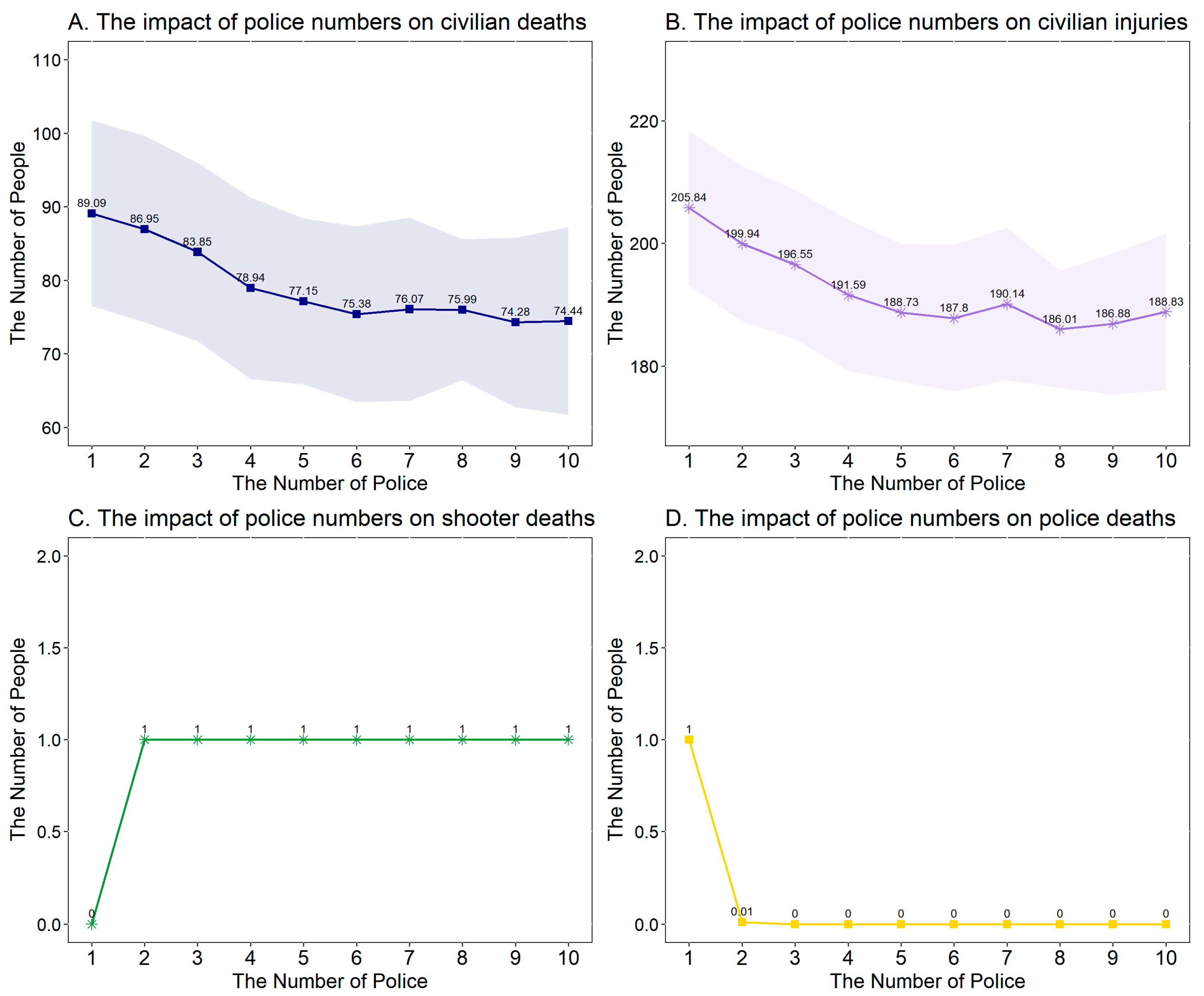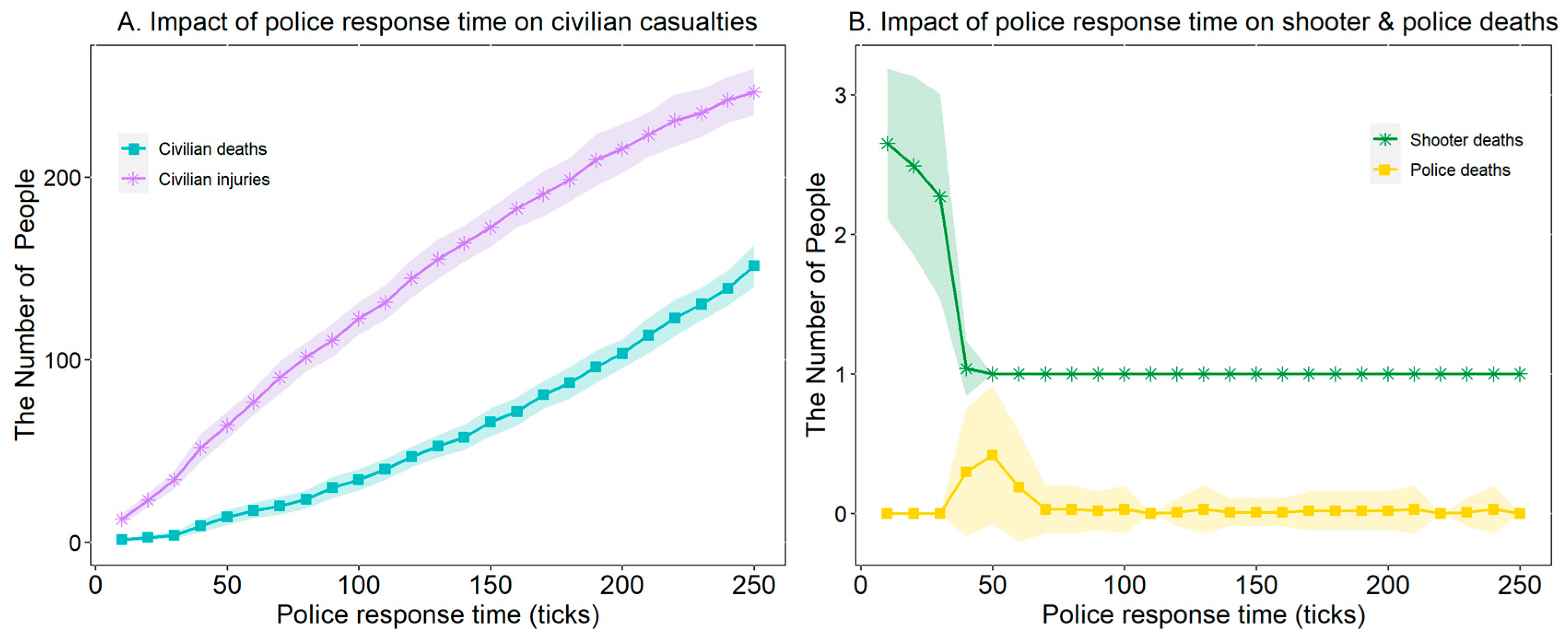Crowd Evacuation Dynamics Under Shooting Attacks in Multi-Story Buildings
Abstract
1. Introduction
2. Materials and Methods
2.1. The Real Target Case
2.2. Environment Setting
2.3. The Mechanism of Pedestrian Dynamics
2.4. Civilian Settings
2.5. Shooter Setting
2.6. Counter-Terrorism Force Setting
3. Optimal Solution Outcomes
3.1. Solving Optimal Solutions
3.2. Validity of the Optimal Solution
3.3. Artificial Neural Network
4. Counterfactual Inference
4.1. The Effective Reconstruction Scheme for Building Safety Exits
4.2. The Optimal Number of Police
4.3. Police Response Time
5. Conclusions and Discussions
Author Contributions
Funding
Data Availability Statement
Conflicts of Interest
References
- Abba-Aji, M.; Koya, S.F.; Abdalla, S.M.; Ettman, C.K.; Cohen, G.H.; Galea, S. The mental health consequences of interpersonal gun violence: A systematic review. SSM-Ment. Health 2024, 5, 100302. [Google Scholar] [CrossRef]
- The Gun Violence Archive. GVA-10 Year Review. January 2025. Available online: https://www.gunviolencearchive.org/query/14c00d51-0b8d-4dd6-a71e-0caa61f54155 (accessed on 22 March 2025).
- Weigend Vargas, E.; Degli Esposti, M.; Hargarten, S.; Vargas, L.; Goldstick, J.E. Examining firearm-related deaths in Mexico, 2015–2022. Inj. Epidemiol. 2024, 11, 33. [Google Scholar] [CrossRef] [PubMed]
- Schneider, R. Fewer guns, less crime: Evidence from Brazil. Econ. Policy 2021, 36, 287–323. [Google Scholar] [CrossRef]
- Toigo, S.; Pollock, N.J.; Liu, L.; Contreras, G.; McFaull, S.R.; Thompson, W. Fatal and non-fatal firearm-related injuries in Canada, 2016–2020: A population-based study using three administrative databases. Inj. Epidemiol. 2023, 10, 10. [Google Scholar] [CrossRef]
- McPhedran, S. Australian mass shootings: An analysis of incidents and offenders. J. Interpers. Violence 2020, 35, 3939–3962. [Google Scholar] [CrossRef]
- Navsaria, P.H.; Nicol, A.J.; Parry, C.D.H.; Matzopoulos, R.; Maqungo, S.; Gaudin, R. The effect of lockdown on intentional and non-intentional injury during the COVID-19 pandemic in Cape Town, South Africa: A preliminary report. S. Afr. Med. J. 2021, 111, 110–113. [Google Scholar] [CrossRef]
- World Population Review. Available online: https://worldpopulationreview.com/country-rankings/gun-deaths-by-country (accessed on 22 March 2025).
- Federal Bureau of Investigation. 2000 to 2018 Active Shooter Incidents. June 2019. Available online: https://www.fbi.gov/file-repository/active-shooter-incidents-2000-2018.pdf/view (accessed on 12 November 2024).
- Gammell, S.P.; Connell, N.M.; Huskey, M.G. A descriptive analysis of the characteristics of school shootings across five decades. Am. J. Crim. Justice 2022, 47, 818–835. [Google Scholar] [CrossRef]
- Keenan, K.; Greene, A. Whiteness or resilience? Placing terror by studying the Charleston, South Carolina mother Emanuel church shooting. Urban Geogr. 2019, 40, 104–127. [Google Scholar] [CrossRef]
- Capellan, J.A.; Silva, J.R. An investigation of mass public shooting attacks against government targets in the United States. Stud. Confl. Terror. 2021, 44, 387–409. [Google Scholar] [CrossRef]
- Wang, D.; Yang, Y.; Zhou, T.; Yang, F. An investigation of fire evacuation performance in irregular underground commercial building affected by multiple parameters. J. Build. Eng. 2021, 37, 102146. [Google Scholar] [CrossRef]
- Xie, W.; Lee, E.W.M.; Li, T.; Shi, M.; Cao, R.; Zhang, Y. A study of group effects in pedestrian crowd evacuation: Experiments, modelling and simulation. Saf. Sci. 2021, 133, 105029. [Google Scholar] [CrossRef]
- Zhang, R.; Liu, D.; Du, E.; Xiong, L.; Chen, J.; Chen, H. An agent-based model to simulate human responses to flash flood warnings for improving evacuation performance. J. Hydrol. 2024, 628, 130452. [Google Scholar] [CrossRef]
- Siam, M.R.K.; Wang, H.; Lindell, M.K.; Chen, C.; Vlahogianni, E.I.; Axhausen, K. An interdisciplinary agent-based multimodal wildfire evacuation model: Critical decisions and life safety. Transp. Res. Part D Transp. Environ. 2022, 103, 103147. [Google Scholar] [CrossRef]
- Bain, N.; Bartolo, D. Dynamic response and hydrodynamics of polarized crowds. Science 2019, 363, 46–49. [Google Scholar] [CrossRef]
- Senanayake, G.P.; Kieu, M.; Zou, Y.; Dirks, K. Agent-based simulation for pedestrian evacuation: A systematic literature review. Int. J. Disaster Risk Reduct. 2024, 111, 104705. [Google Scholar] [CrossRef]
- Khamis, N.; Selamat, H.; Ismail, F.S.; Lutfy, O.F.; Haniff, M.F.; Nordin, I.N.A.M. Optimized exit door locations for a safer emergency evacuation using crowd evacuation model and artificial bee colony optimization. Chaos Solitons Fractals 2020, 131, 109505. [Google Scholar] [CrossRef]
- Ren, J.; Mao, Z.; Gong, M.; Zuo, S. Modified social force model considering emotional contagion for crowd evacuation simulation. Int. J. Disaster Risk Reduct. 2023, 96, 103902. [Google Scholar] [CrossRef]
- Liang, H.; Lee, S.; Sun, J.; Wong, S.C. Unraveling the causes of the Seoul Halloween crowd-crush disaster. PLoS ONE 2024, 19, e0306764. [Google Scholar] [CrossRef]
- Arteaga, C.; Park, J. Building design and its effect on evacuation efficiency and casualty levels during an indoor active shooter incident. Saf. Sci. 2020, 127, 104692. [Google Scholar] [CrossRef]
- Young, E.; Aguirre, B. PrioritEvac: An agent-based model (ABM) for examining social factors of building fire evacuation. Inf. Syst. Front. 2021, 23, 1083–1096. [Google Scholar] [CrossRef]
- Hassanpour, S.; Gonzalez, V.; Liu, J.; Zou, Y.; Cabrera-Guerrero, G. A hybrid hierarchical agent-based simulation approach for buildings indoor layout evaluation based on the post-earthquake evacuation. Adv. Eng. Inform. 2022, 51, 101531. [Google Scholar] [CrossRef]
- Cotfas, L.A.; Delcea, C.; Iancu, L.D.; Ioanăş, C.; Ponsiglione, C. Large event halls evacuation using an agent-based modeling approach. IEEE Access 2022, 10, 49359–49384. [Google Scholar] [CrossRef]
- Grajdura, S.; Borjigin, S.; Niemeier, D. Fast-moving dire wildfire evacuation simulation. Transp. Res. Part D Transp. Environ. 2022, 104, 103190. [Google Scholar] [CrossRef]
- Saeed, R.A.; Recupero, D.R.; Remagnino, P. Simulating crowd behaviour combining both microscopic and macroscopic rules. Inf. Sci. 2022, 583, 137–158. [Google Scholar] [CrossRef]
- Lancel, S.; Chapurlat, V.; Dray, G.; Martin, S. Emergency evacuation in a supermarket during a terrorist attack: Towards a possible modelling of the influence of affordances on the evacuation behavior of agents in a complex virtual environment. J. Saf. Sci. Resil. 2023, 4, 139–150. [Google Scholar] [CrossRef]
- Keykhaei, M.; Samany, N.N.; Jelokhani-Niaraki, M.; Zlatanova, S. Multi-agent-based human cognition simulation of Situation-aware earthquake emergency evacuation. Int. J. Disaster Risk Reduct. 2024, 100, 104183. [Google Scholar] [CrossRef]
- Kapadia, K.; Yongsatianchot, N.; Marsella, S.; John, R. Integrating Actual Human Behavior into an Agent-Based School Shooting Simulation. In Proceedings of the 2024 Winter Simulation Conference (WSC), Orlando, FL, USA, 15–18 December 2024; IEEE: Piscataway, NJ, USA, 2024; pp. 2094–2105. [Google Scholar]
- Liu, R.; Fu, Z.; Schadschneider, A.; Wen, Q.; Chen, J.; Liu, S. Modeling the effect of visibility on upstairs crowd evacuation by a stochastic FFCA model with finer discretization. Phys. A Stat. Mech. Its Appl. 2019, 531, 121723. [Google Scholar] [CrossRef]
- Li, Z. Pedestrian evacuation within limited-space buildings based on different exit design schemes. Saf. Sci. 2020, 124, 104575. [Google Scholar] [CrossRef]
- Berseth, G.; Usman, M.; Haworth, B.; Kapadia, M.; Faloutsos, P. Environment optimization for crowd evacuation. Comput. Animat. Virtual Worlds 2015, 26, 377–386. [Google Scholar] [CrossRef]
- Zhu, Y.; Chen, T.; Ding, N.; Chraibi, M.; Fan, W.C. Follow the evacuation signs or surrounding people during building evacuation, an experimental study. Phys. A Stat. Mech. Its Appl. 2020, 560, 125156. [Google Scholar] [CrossRef]
- Ding, N. The effectiveness of evacuation signs in buildings based on eye tracking experiment. Nat. Hazards 2020, 103, 1201–1218. [Google Scholar] [CrossRef]
- Zhou, M.; Dong, H.; Wang, X.; Hu, X.; Ge, S. Modeling and simulation of crowd evacuation with signs at subway platform: A case study of Beijing subway stations. IEEE Trans. Intell. Transp. Syst. 2020, 23, 1492–1504. [Google Scholar] [CrossRef]
- Helbing, D.; Molnar, P. Social force model for pedestrian dynamics. Phys. Rev. E 1995, 51, 4282. [Google Scholar] [CrossRef] [PubMed]
- Helbing, D.; Farkas, I.; Vicsek, T. Simulating dynamical features of escape panic. Nature 2000, 407, 487–490. [Google Scholar] [CrossRef]
- Lu, X.; Astur, R.; Gifford, T. Effects of gunfire location information and guidance on improving survival in virtual mass shooting events. Int. J. Disaster Risk Reduct. 2021, 64, 102505. [Google Scholar] [CrossRef]
- Mittal, V.; Evangelista, P.F. Accounting for Individual Shooting Skills in Combat Models. In 2023 Winter Simulation Conference (WSC); IEEE: Piscataway, NJ, USA, 2023; pp. 2379–2390. [Google Scholar]
- Marufuzzaman, M.; Aghalari, A.; Ranta, J.H.; Jaradat, R. Optimizing civilian response strategy under an active shooting incident. IEEE Syst. J. 2021, 15, 4804–4815. [Google Scholar] [CrossRef]
- Carson, J.V.; Dugan, L.; Yang, S.M. A comprehensive application of rational choice theory: How costs imposed by, and benefits derived from, the US federal government affect incidents perpetrated by the radical eco-movement. J. Quant. Criminol. 2020, 36, 701–724. [Google Scholar] [CrossRef]
- Dugan, L.; LaFree, G.; Piquero, A.R. Testing a rational choice model of airline hijackings. Criminology 2005, 43, 1031–1065. [Google Scholar] [CrossRef]
- Arce, D.G.; Sandler, T. Terrorist signalling and the value of intelligence. Br. J. Political Sci. 2007, 37, 573–586. [Google Scholar] [CrossRef]
- Lu, P.; Li, Y.; Wen, F.; Chen, D. Agent-based modeling of mass shooting case with the counterforce of policemen. Complex Intell. Syst. 2023, 9, 5093–5113. [Google Scholar] [CrossRef]
- Liu, W.; Taylor, B. The effect of body armor on saving officers’ lives: An analysis using LEOKA data. J. Occup. Environ. Hyg. 2017, 14, 73–80. [Google Scholar] [CrossRef] [PubMed]
- Phillips, S.W. Police response to active shooter events: How officers see their role. Police Q. 2020, 23, 262–279. [Google Scholar] [CrossRef]
- Gibbs, J.C. Terrorist attacks targeting police, 1998–2010: Exploring heavily hit countries. Int. Crim. Justice Rev. 2020, 30, 261–278. [Google Scholar] [CrossRef]
- Wurzer, G.; Kowarik, K.; Reschreiter, H. (Eds.) Agent-Based Modeling and Simulation in Archaeology; Springer International Publishing: Cham, Switzerland, 2015. [Google Scholar]
- Owaidah, A.; Olaru, D.; Bennamoun, M.; Sohel, F.; Khan, N. Review of modelling and simulating crowds at mass gathering events: Hajj as a case study. J. Artif. Soc. Soc. Simul. 2019, 22, 1–36. [Google Scholar] [CrossRef]
- Bandini, S.; Manzoni, S.; Vizzari, G. Agent based modeling and simulation: An informatics perspective. J. Artif. Soc. Soc. Simul. 2009, 12, 4. [Google Scholar]
- Jadbabaie, A.; Molavi, P.; Tahbaz-Salehi, A. Information heterogeneity and the speed of learning in social networks. Writ. Technol. eJournal 2013, 91, 2266979. [Google Scholar] [CrossRef]
- Kowalska-Pyzalska, A. Willingess to pay for green energy: An agent-based model in NetLogo platform. In Proceedings of the 2017 14th International Conference on the European Energy Market (EEM), Dresden, Germany, 6–9 June 2017; IEEE: Piscataway, NJ, USA, 2017; pp. 1–6. [Google Scholar]
- Wang, Z.; Butner, J.D.; Kerketta, R.; Cristini, V.; Deisboeck, T.S. Simulating cancer growth with multiscale agent-based modeling. Semin. Cancer Biol. 2015, 30, 70–78. [Google Scholar] [CrossRef]
- Krogh, A. What are artificial neural networks? Nat. Biotechnol. 2008, 26, 195–197. [Google Scholar] [CrossRef]
- Wikipedia. November 2015 Paris Attacks. March 2025. Available online: https://en.wikipedia.org/wiki/November_2015_Paris_attacks (accessed on 12 March 2025).
- Wikipedia. Bataclan (Theatre). March 2025. Available online: https://en.wikipedia.org/wiki/Bataclan_(theatre) (accessed on 12 March 2025).
- Quarantelli, E.L. Panic behavior: Some empirical observations. In Proceedings of the American Institute of Architects Conference on Human Response to Tall Buildings, Chicago, IL, USA, 19 July 1975. [Google Scholar]
- Saloma, C.; Perez, G.J.; Tapang, G.; Lim, M.; Palmes-Saloma, C. Self-organized queuing and scale-free behavior in real escape panic. Proc. Natl. Acad. Sci. USA 2003, 100, 11947–11952. [Google Scholar] [CrossRef]
- Illiyas, F.T.; Mani, S.K.; Pradeepkumar, A.P.; Mohan, K. Human stampedes during religious festivals: A comparative review of mass gathering emergencies in India. Int. J. Disaster Risk Reduct. 2013, 5, 10–18. [Google Scholar] [CrossRef]
- Daoliang, Z.; Lizhong, Y.; Jian, L. Exit dynamics of occupant evacuation in an emergency. Phys. A Stat. Mech. Its Appl. 2006, 363, 501–511. [Google Scholar] [CrossRef]
- Cao, S.; Song, W.; Lv, W.; Fang, Z. A multi-grid model for pedestrian evacuation in a room without visibility. Phys. A Stat. Mech. Its Appl. 2015, 436, 45–61. [Google Scholar] [CrossRef]
- Rexstad, E.A.; Anderson, D.R. Heterogeneous survival rates of mallards (Anas platyrhynchos). Can. J. Zool. 1992, 70, 1878–1885. [Google Scholar] [CrossRef]
- Choi, S.; Fisman, R.; Gale, D.; Kariv, S. Consistency and heterogeneity of individual behavior under uncertainty. Am. Econ. Rev. 2007, 97, 1921–1938. [Google Scholar] [CrossRef]
- Richter, K.F.; Shi, M.; Gan, H.S.; Winter, S. Decentralized evacuation management. Transp. Res. Part C Emerg. Technol. 2013, 31, 1–17. [Google Scholar] [CrossRef]
- Yang, X.Y.; Hu, A.; Schieman, S. Relative deprivation in context: How contextual status homogeneity shapes the relationship between disadvantaged social status and health. Soc. Sci. Res. 2019, 81, 157–169. [Google Scholar] [CrossRef]
- Hu, A. Can Education Make Us Healthier? An Urban-Rural Comparative Analysis Based on the Chinese General Social Survey of 2010. Soc. Sci. China 2015, 36, 64–82. [Google Scholar]
- Ngo, E.B. Elderly people and disaster. In Handbook of Hazards and Disaster Risk Reduction; Routledge: London, UK, 2012; pp. 447–458. [Google Scholar]
- Lu, P.; Yang, H.; Li, H.; Li, M.; Zhang, Z. Swarm intelligence, social force and multi-agent modeling of heroic altruism behaviors under collective risks. Knowl.-Based Syst. 2021, 214, 106725. [Google Scholar] [CrossRef]
- LaFree, G.; Dugan, L.; Xie, M.; Singh, P. Spatial and temporal patterns of terrorist attacks by ETA 1970 to 2007. J. Quant. Criminol. 2012, 28, 7–29. [Google Scholar] [CrossRef]
- Wales, C.R.J. Zeroing in on Optics: Professional Firearm Optics Training for the Modern Shooter; FriesenPress: Altona, MB, Canada, 2023. [Google Scholar]
- Arteaga, C.; Park, J.; Morris, B.T.; Sharma, S. Effect of trained evacuation leaders on victims’ safety during an active shooter incident. Saf. Sci. 2023, 158, 105967. [Google Scholar] [CrossRef]
- Dasgupta, D. Artificial neural networks and artificial immune systems: Similarities and differences. In Proceedings of the 1997 IEEE International Conference on Systems, Man, and Cybernetics. Computational Cybernetics and Simulation, Orlando, FL, USA, 12–15 October 1997; IEEE: Piscataway, NJ, USA, 1997; Volume 1, pp. 873–878. [Google Scholar]







| Source | Methods | Application Scenarios | Major Contributions/Findings | Detection of Parameter of Predictive Stability | Real Case Matching | Software |
|---|---|---|---|---|---|---|
| Arteaga et al. (2020) [22] | Social force model and ABM | Shooting incident | Increasing hall and door widths can improve evacuation efficiency and safety. | No | No | Java |
| Young et al. (2021) [23] | ABM | Building fire evacuation | Architectural design and evacuation planning should take into account human behavior. | No | No | NetLogo |
| Hassanpour et al. (2022) [24] | ABM and reinforcement learning | Earthquake | Provided a simulation method for evaluating the performance of indoor building design based on human evacuation behavior. | No | Yes | NetLogo 6.0.4 |
| Cotfas et al. (2022) [25] | ABM | Large-scale event | An “adapted cone exit” can guide people towards the nearest exit. | No | No | NetLogo 6.2.2 |
| Grajdura et al. (2022) [26] | ABM | Fire | Longer evacuation times are linked to less smartphone use, more awareness delays, and fewer vehicle accesses. | No | Yes | NetLogo |
| Saeed et al. (2022) [27] | ABM | Virtual environment | Mode capable of simulating large numbers of pedestrians in complex environments. | No | No | Python and Autodesk Maya |
| Siam et al. (2022) [16] | ABM | Wildfire evacuation | The separation of pedestrian and vehicle traffic can reduce mortality rates. | No | Yes | NetLogo |
| Lancel et al. (2023) [28] | Multi-agent systems | Terrorist attacks | Changing environmental affordances alters participants’ decision-making. | No | No | Unspecified |
| Keykhaei et al. (2024) [29] | Multi-agent simulation and Bayesian inference | Earthquake | Human cognition of situation-aware emergency evacuation was simulated. | Yes | No | NetLogo |
| Kapadia et al. (2024) [30] | ABM | Campus shooting | Mixed agent behavior and lower dispatch times had the greatest influence on casualties. | No | No | NetLogo 6.4 |
| Terminology/Parameter (Unit) | Interpretations | Parameter Traversal Range (Step Size) | Optimal Solution Value |
|---|---|---|---|
| The number of civilians (people) | The size of the civilian group | 1500 | 1500 |
| The number of terrorists (people) | The size of the terrorist group | 3 | 3 |
| Shooting damage (blood) | The damage from each shooting | 50~70 (0.1) | 56.8 |
| Perception radius (patches) | How far the agents can see | 1~40 (1) | 5 |
| Injured blood volume (%) | The decrease in the proportion of civilians’ blood counts as injuries | 20~100 (1)% | 40% |
| Collision damage (blood) | The blood loss of the collision at one time | 0~0.1 (0.01) | 0.05 |
| Tumble probability (%) | The probability that civilians fall | 0~10 (0.01)% | 0.04% |
| Police response time (ticks) | The time when the police entered the scene | 5~400 (5) | 180 |
| Number of police (people) | The size of the police group | 2 | 2 |
| Damage from police shootings (blood) | The damage from police shooting | 0~100 (1) | 41 |
| Distance of shooting (patches) | How far the agents can shoot | 0~100 (1) | 40 |
| Police defense (%) | The defense ability of the police officers | 0~100 (5)% | 95% |
| Tramping damage (blood) | When civilians fall and are trampled by civilians around them | 0~20 (1) | 10 |
Disclaimer/Publisher’s Note: The statements, opinions and data contained in all publications are solely those of the individual author(s) and contributor(s) and not of MDPI and/or the editor(s). MDPI and/or the editor(s) disclaim responsibility for any injury to people or property resulting from any ideas, methods, instructions or products referred to in the content. |
© 2025 by the authors. Licensee MDPI, Basel, Switzerland. This article is an open access article distributed under the terms and conditions of the Creative Commons Attribution (CC BY) license (https://creativecommons.org/licenses/by/4.0/).
Share and Cite
Chen, D.; Lu, P.; Niu, Y.; Lv, P. Crowd Evacuation Dynamics Under Shooting Attacks in Multi-Story Buildings. Systems 2025, 13, 310. https://doi.org/10.3390/systems13050310
Chen D, Lu P, Niu Y, Lv P. Crowd Evacuation Dynamics Under Shooting Attacks in Multi-Story Buildings. Systems. 2025; 13(5):310. https://doi.org/10.3390/systems13050310
Chicago/Turabian StyleChen, Dianhan, Peng Lu, Yaping Niu, and Pengfei Lv. 2025. "Crowd Evacuation Dynamics Under Shooting Attacks in Multi-Story Buildings" Systems 13, no. 5: 310. https://doi.org/10.3390/systems13050310
APA StyleChen, D., Lu, P., Niu, Y., & Lv, P. (2025). Crowd Evacuation Dynamics Under Shooting Attacks in Multi-Story Buildings. Systems, 13(5), 310. https://doi.org/10.3390/systems13050310





